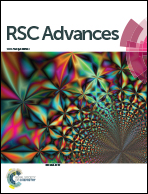A DFT study on the reaction mechanism between tetrachloro-o-benzoquinone and H2O2 and an alternative reaction approach to produce the hydroxyl radical†
Abstract
The formation of hydroxyl and alkoxyl radicals in the reaction of halogenated quinones and organic hydroperoxides can be used to elucidate the potential carcinogenicity of polyhalogenated aromatic environmental pollutants. To further enrich the understanding of the reactivity of the halogenated quinones with organic hydroperoxides, in this study, the reaction mechanism of tetrachloro-o-benzoquinone (o-TCBQ) with H2O2 has been systematically investigated at the B3LYP/6-311++G** level. It was found that a molecular complex was formed as the first step of the title reaction. After that, the nucleophilic attack of H2O2 on o-TCBQ occurs to produce an unstable intermediate containing an O–O bond. Subsequently, the unstable intermediate decomposes homolytically via the cleavage of the O–O bond, resulting in the formation of the OH radical. Note that explicit water molecules play an important positive role in the nucleophilic attack process. The nucleophilic attack process is the rate-determining step in the whole reaction. Moreover, selected substitution effects on the title reaction have also been studied. In addition, as an alternative reaction approach, it was found that the formed unstable intermediate containing an O–O bond mentioned above can be produced directly from the nucleophilic attack of the anionic form of H2O2 on o-TCBQ in the absence of explicit water molecules.



 Please wait while we load your content...
Please wait while we load your content...